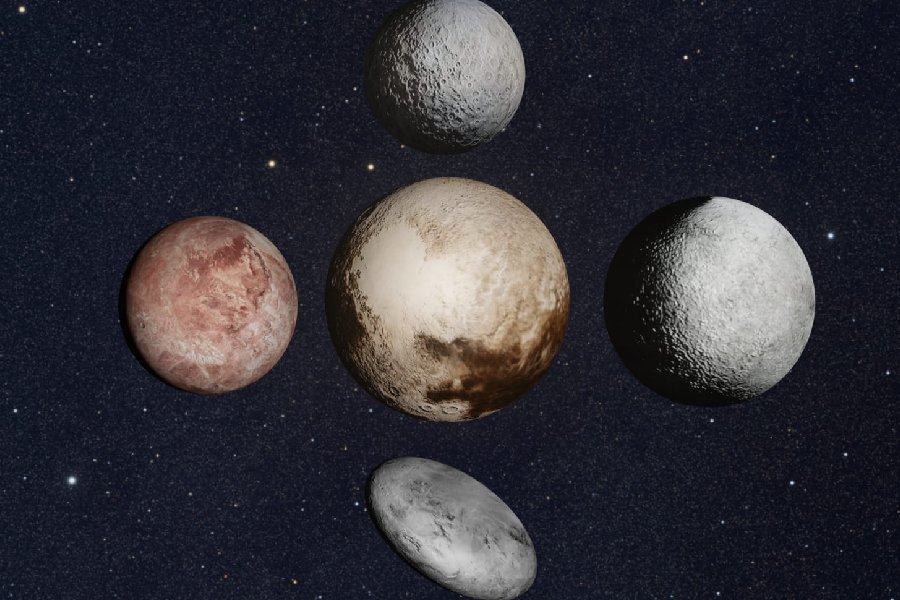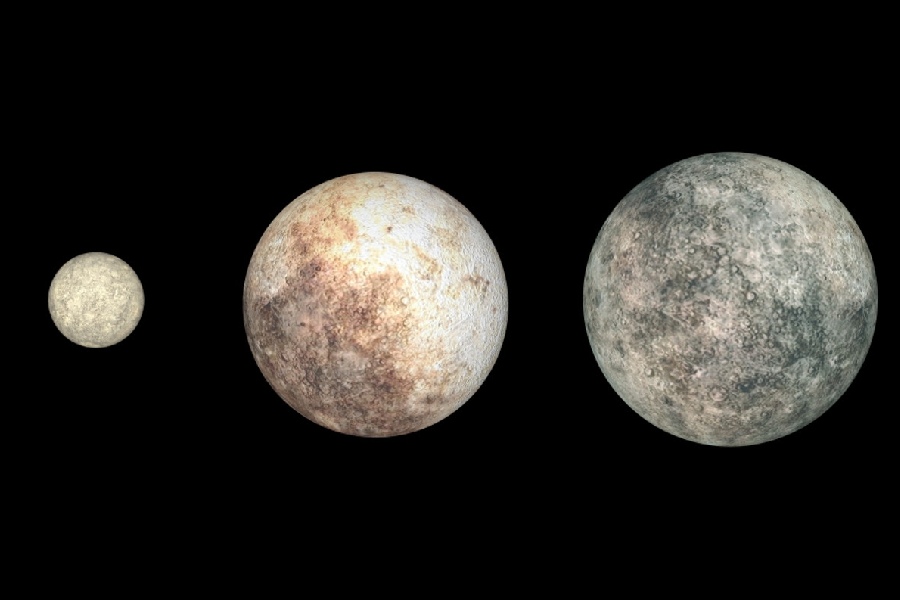Our Solar System is home to many fascinating objects, including the eight major planets orbiting the Sun. But did you know there are even more worlds beyond the orbits of Neptune and Pluto? These dwarf planets reside in the outskirts of the Solar System.
They are just now coming into focus as we explore further out into space. Though diminutive in size compared to the major planets, dwarf planets possess many intriguing traits. Their smaller size gives clues about how planets form and evolve over time.
Dwarf planets have their own moons, atmospheres, and likely hidden oceans in some cases. There is much to discover about these distant, miniature marvels.
In this article, we will survey the dwarf planets in our Solar System we’ve found so far. What makes them different from regular planets? What do they reveal about our Solar System’s past? What secrets do they still hold? Read on to encounter the dwarf planets and learn what makes each one special.

Dwarf Planets in Our Solar System
Dwarf planets in our Solar System are celestial bodies that share characteristics with both planets and asteroids. Unlike traditional planets, they haven’t cleared their orbital paths of debris.
The International Astronomical Union currently recognizes five dwarf planets in our Solar System: Pluto, Eris, Haumea, Makemake, and Ceres. Pluto, once considered the ninth planet, is the most famous among them.
These dwarf planets are located in the outer regions of the Solar System, beyond the orbit of Neptune. While smaller than the major planets, dwarf planets play a significant role in expanding our understanding of the diverse objects inhabiting our celestial neighborhood.
The Categories of Dwarf Planets
Introduction to dwarf planets
Dwarf planets are a class of planetary-mass objects that orbit the Sun. They are smaller than full-sized planets but larger than small Solar System bodies like asteroids and comets.
There are currently five recognized dwarf planets in our Solar System – Ceres, Pluto, Haumea, Makemake, and Eris.
Dwarf planets have enough mass and gravity to form into spheres. However, they do not have enough gravity to clear debris from their orbital path. Pluto orbits the Sun, sharing its path with other Kuiper belt objects. All dwarf planets orbit the Sun beyond Neptune in the outer Solar System.
The largest dwarf planet is Pluto. It resides in the Kuiper belt past Neptune’s orbit. Ceres is the only dwarf planet in the inner Solar System and orbits in the asteroid belt. Distant dwarf planets like Eris and Makemake orbit far out in the scattered disc.
Dwarf planet classification criteria
The International Astronomical Union officially defines a dwarf planet – an object must meet certain criteria related to its size, shape, and orbital path. Determining if a Solar System body is a dwarf planet depends on:
- Orbital dominance – A dwarf planet must orbit the Sun and not another body like a planet or moon. It does not dominate its orbital path by gravitationally clearing it of debris. This differs from major planets like Earth that have cleared their orbits.
- Spherical shape – The object must have enough mass and gravity to pull itself into a rounded shape. Small asteroids tend to be irregular, while planets and dwarf planets form spheres. Larger objects have sufficient gravity for hydrostatic equilibrium.
- Not a satellite – A dwarf planet cannot be a moon orbiting another object. For example, Titan orbits Saturn but is not a dwarf planet itself. A dwarf planet orbits the Sun directly. Moons are excluded from dwarf planet status by definition.
Dwarf Planet’s Role in the Solar System
Dwarf planets provide clues about how the Solar System formed and evolved. Their prevalence shows larger planets are the exception, not the norm.
Dwarf planets demonstrate how smaller worlds assemble through accretion. Their study leads to new insights into planetary formation processes.
Dwarf planets help shape the structure and dynamics of the outer Solar System. Their gravitational influence sculpts the Kuiper belt’s form.
Interactions with dwarf planets can perturb the orbits of smaller objects like comets and asteroids. Dwarf planets are crucial components of the architecture beyond Neptune.

History of Discovery
Pioneering observations
Ceres was discovered in 1801 by Giuseppe Piazzi in Palermo. Located in the asteroid belt, Ceres was considered a planet at first. It appeared as a faint disk, unusual for an asteroid. Ceres orbits between Mars and Jupiter in the asteroid belt region. Piazzi’s discovery marked the first of an eventual dwarf planet.
Clyde Tombaugh imaged Pluto for the first time in 1930 after a search lasting over a year. Pluto showed up as a tiny speck moving against stationary stars. Finding Pluto completed the set of known planets.
Newer telescopes advanced dwarf planet detections. Haumea and Makemake were spotted using advanced digital equipment in the early 2000s. Improved optics and imaging aid dwarf planet hunting.
Better technology allows exploration of the outer Solar System. This led to finds of distant dwarfs like Eris in the scattered disc beyond Neptune. Dwarf planets chart the fringes of our star system.
Early detection of dwarf planets pushed the boundaries of telescopes and photographic plates. Long exposures were needed to capture enough light from these distant, small objects. Astronomers had to account for the motion of both Earth and the target.
Characteristics and Attributes of Dwarf Planets
Spherical shape and hydrostatic equilibrium
Dwarf planets are round celestial bodies, and their structure differs from irregularly-shaped asteroids.
Dwarf planets’ own gravity shapes them into spheres, though they are small. The spherical shape is a key attribute that distinguishes dwarf planets, and hydrostatic equilibrium is what produces their rounded form.
So, the materials comprising a dwarf planet are supported by hydrostatic equilibrium. This balances the outward pressure of materials against gravitational collapse.
Orbital paths around the sun
All recognized dwarf planets have orbits located beyond Neptune’s orbit. Many dwarf planets reside in the Kuiper belt and scattered disc regions. Their distance sets them apart from the inner rocky planets.
Dwarf planets do not clear debris from their orbital path by gravity. So, they share their orbital zone with other objects like comets or asteroids. This differs from major planets that dominate their orbital path because their orbits are congested.
Composition – Icy bodies and solid bodies
Icy bodies
Many dwarf planets have significant ice content, such as Pluto and Eris. Their distance from the Sun allows icy compounds to remain solid on their surfaces and interiors. Their icy composition is a defining feature.
However, some dwarf planets like Ceres are rockier and less icy. Their composition resembles terrestrial planets, though they are much smaller than Earth. They have higher rock content. The ratio of rock to ice depends on where the object formed in the Solar System.
Carbon monoxide presence in atmosphere
Some dwarf planets have trace amounts of carbon monoxide gas in their tenuous atmospheres, such as Makemake. This provides clues about their origin and evolution. It indicates primordial retention.
Carbon monoxide’s presence indicates dwarf planets likely retain materials from the original solar nebula. Studying their atmospheres enhances our understanding of dwarf planets, and of course, more atmospheric study is needed.

Michael Brown’s Contribution to Dwarf Planet Research
Astronomer’s impact
Michael E. Brown is a professor at Caltech. He led the discovery of many dwarf planets. He found Haumea, Makemake, Sedna, and Eris. His team researched size, shape, and surfaces. Brown identified many new dwarf planets.
Brown’s discoveries prompted debate on definitions. This led to a new dwarf planet category in 2006. His work catalyzed a richer understanding of the outer Solar System. He reshaped our Solar System model.
Brown continues investigating dwarf planets today and by using advanced equipment, he searches for new ones. He studies current dwarfs, seeking insights about geology and composition. Brown remains a leader in dwarf planet astronomy. He is a pioneer in the field.
Researching dwarf planet eris
In 2003, Brown’s team discovered Eris, larger than Pluto. Its size suggested Pluto was not unique, requiring dwarf planet designation. This finding ignited intense scientific debate. It challenged existing notions.
Brown characterized Eris’ orbit, methane ice content, and reflective bright surface. He named it after the Greek goddess of discord and strife. Further study is still uncovering new details about distant Eris. Much is still unknown.
The discovery of Eris prompted the International Astronomical Union to define dwarf planets as distinct from main planets. This major milestone shaped our current Solar System model thanks to Brown’s work. His work rewrote celestial models.
Popularizing dwarf planet science
Brown’s discoveries have brought dwarf planets into mainstream focus. He named features on them, drawing public interest. He advocates teaching revised Solar System models in schools. Brown’s work propelled dwarf planets into the public spotlight as he made them accessible.
Recent Findings and Discoveries
Advancements in technology
Better telescopes and cameras enable dwarf planets to be imaged clearly. Detailed views of surfaces and features are now possible from advanced optics. Spectral studies also enhance knowledge.
Sending spacecraft to dwarf planets marks a major milestone. The Dawn and New Horizons probes visited Ceres and Pluto up close for the first time. Direct observation aids research. These missions gather detailed data on composition and geology.
Increased computing power permits finding faint, distant dwarfs. Automated sky surveys using powerful tools identify potential new candidates in the outer Solar System. More dwarf planets likely await discovery in the Kuiper belt.
Ongoing exploration missions
The Dawn spacecraft orbited Ceres from 2015 to 2018. It imaged cratered terrain and observed geology and composition. Dawn gave us rich data on the asteroid belt’s dwarf planet. The mission greatly expanded knowledge of Ceres.
In 2015, New Horizons performed history’s first flyby of Pluto. Findings included nitrogen ice glaciers and a layered atmosphere. It continues studying other Kuiper belt objects. New Horizons sent back unprecedented data on Pluto.
Future proposed missions would target additional dwarf planets. Ideas include probes to Sedna, Quaoar, Haumea, Makemake, Eris, and others. We aim to directly sample more dwarfs. More missions will further unlock dwarf planet mysteries.
Conclusion
We hope this article has illuminated the special attributes and mysteries of dwarf planets in our Solar System. Through exploring their qualifying traits, major discoveries, and remarkable residents, you now better comprehend the significance of dwarf planets in the cosmic landscape.
While diminutive compared to the major planets, these planetary underdogs reveal invaluable insights that enrich our understanding of our solar neighborhood.
As the list of officially recognized dwarf planets continues to grow, so too will their importance in unraveling the secrets of our stellar family. May these tiny titans inspire awe and fuel our passion to probe ever deeper into the farthest reaches of our cosmic home.
